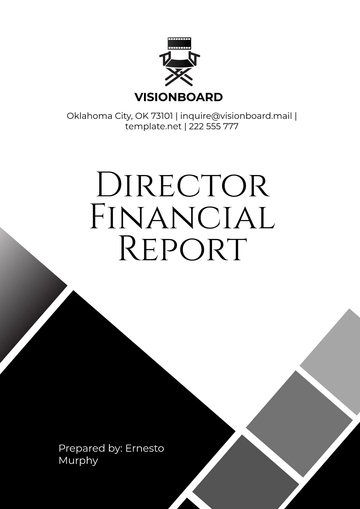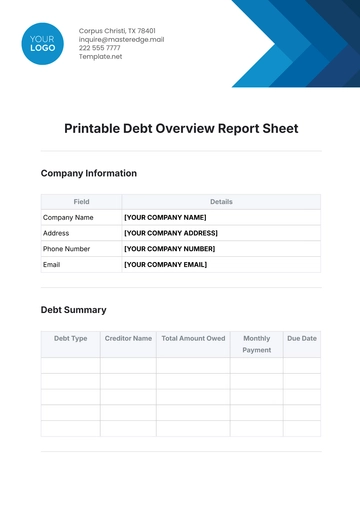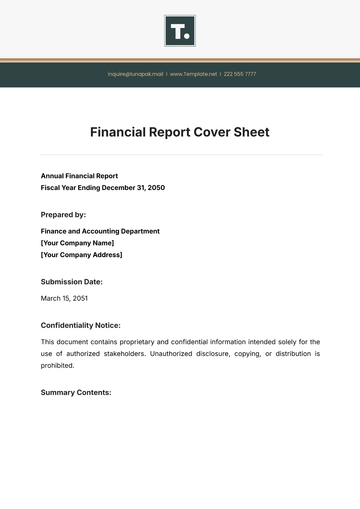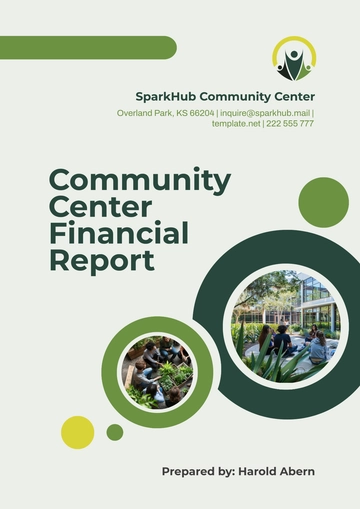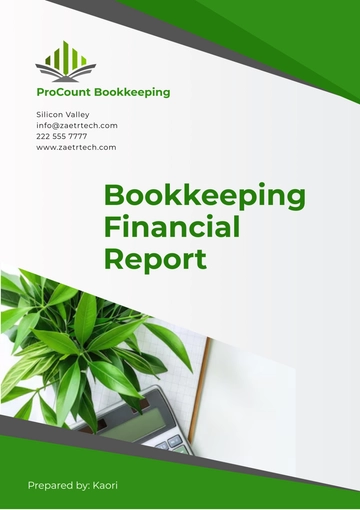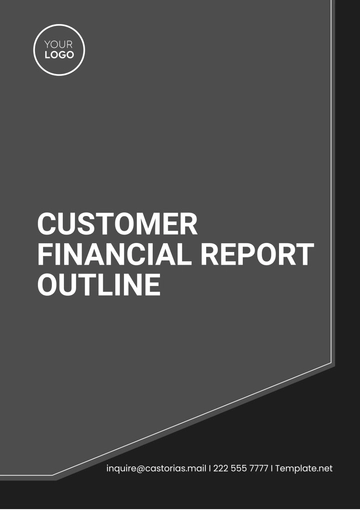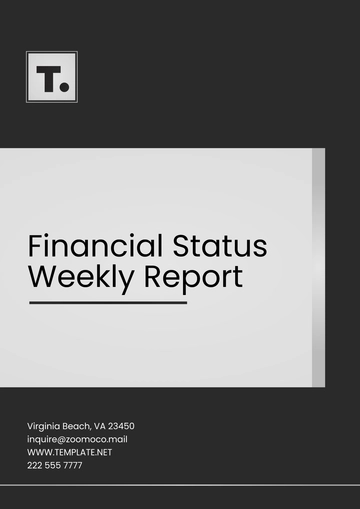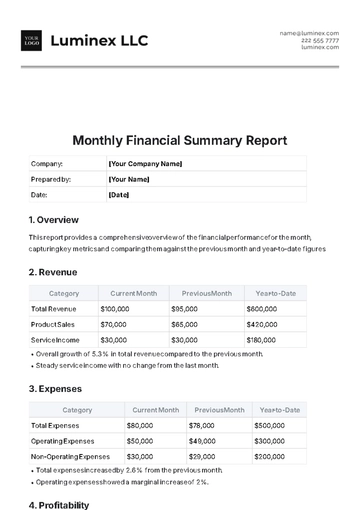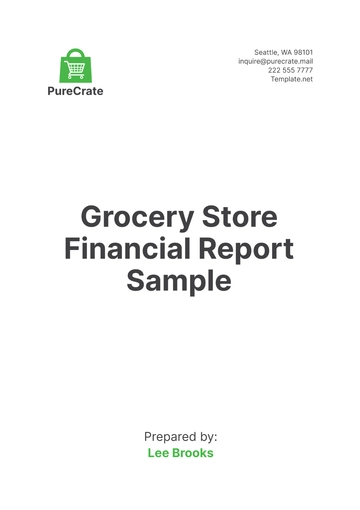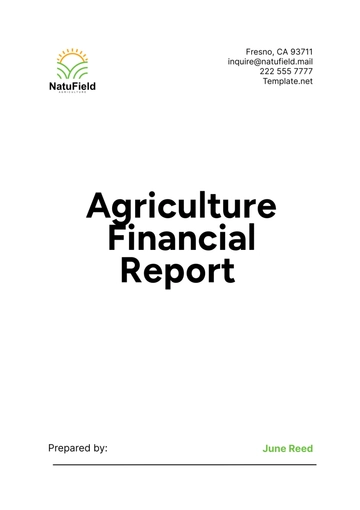Free Simple Financial Report

Prepared by: [YOUR NAME]
Company: [YOUR COMPANY NAME]
Department: [YOUR DEPARTMENT]
Date: [DATE]
I. Introduction
In this section, provide a brief overview of the financial report and its purpose. [YOUR NAME] should introduce the report and its significance to [YOUR COMPANY NAME]. Outline the key financial areas that will be covered in the document. Consider including:
Explanation of the time period covered by the report.
Overview of the financial performance objectives.
Importance of financial reporting for decision-making.
For instance, [YOUR DEPARTMENT] has compiled the financial data for the fiscal year [20XX] to evaluate [YOUR COMPANY NAME]'s financial performance and provide insights for future planning. This report aims to present a concise summary of the company's financial status, including revenue, expenses, and profitability.
II. Financial Highlights
In this section, highlight the key financial metrics and performance indicators for the reporting period. [YOUR NAME] should provide a snapshot of the company's financial health. Consider including:
Total revenue and its sources.
Operating expenses breakdown.
Net income or loss.
Key ratios such as profitability margin or liquidity ratios.
For example, during the fiscal year [20XX], [YOUR COMPANY NAME] achieved a total revenue of $X million, driven primarily by sales of [PRODUCT] and [PRODUCT]. Operating expenses, including [ITEM 1], [ITEM 2], and [ITEM 3], were effectively managed, resulting in a net income of $Y million. The profitability margin stood at Z%, indicating the company's ability to generate profits from its operations.
III. Financial Performance Analysis
In this section, provide a detailed analysis of the company's financial performance. [YOUR NAME] should delve deeper into the factors influencing the financial results. Consider including:
Trend analysis of revenue and expenses.
Variance analysis comparing actual performance to budget or previous periods.
Identification of areas of strength and areas needing improvement.
For instance, the analysis reveals a steady increase in revenue over the past three years, attributed to successful marketing campaigns and expansion into new markets. However, operating expenses have also shown an upward trend, primarily due to [REASON 1] and [REASON 2]. While the company has maintained a positive net income, there is room for optimization in cost management to improve overall profitability.
IV. Financial Forecast
In this section, provide a forecast of the company's financial performance for the upcoming period. [YOUR NAME] should use historical data and market trends to make informed projections. Consider including:
Revenue projections based on sales forecasts.
Expense forecasts considering anticipated changes or investments.
Cash flow projections to ensure liquidity.
For example, based on current market trends and sales projections, [YOUR COMPANY NAME] anticipates a X% increase in revenue for the next fiscal year. However, rising operational costs may impact profitability, necessitating strategic cost-saving measures. Cash flow forecasts indicate sufficient liquidity to support planned investments and operations.
V. Findings:
Revenue Growth: The trend analysis indicates consistent revenue growth over the past three years, with an average annual increase of 8%. This growth can be attributed to successful product launches and expanding market share in key regions.
Cost Management: Operating expenses have risen by 12% compared to the previous year, mainly due to increased marketing expenditures and higher raw material costs. Despite efforts to control costs, there is a need for further optimization in expense management.
Profitability Margin: While the company maintains a healthy profitability margin of 15%, there has been a slight decline compared to the previous year. This decline is primarily due to rising operational costs, emphasizing the importance of cost containment measures.
VI. Recommendations:
Cost Optimization: Implement cost-saving measures such as renegotiating supplier contracts, streamlining operational processes, and leveraging technology to automate tasks where possible. This will help mitigate the impact of rising expenses on profitability.
Diversification of Revenue Streams: Explore opportunities to diversify revenue streams by introducing new products or services, entering new markets, or expanding existing customer segments. This will reduce reliance on a single source of revenue and enhance overall financial stability.
Investment in Innovation: Allocate resources towards research and development to innovate existing products or develop new offerings that cater to evolving customer needs. Investing in innovation will not only drive revenue growth but also maintain a competitive edge in the market.
Monitoring and Adjustment: Establish regular financial performance reviews to monitor progress against forecasted targets and make necessary adjustments to strategies as needed. This proactive approach will ensure agility in responding to changing market conditions and optimizing financial outcomes.
VII. Conclusion
In conclusion, this financial report provides valuable insights into [YOUR COMPANY NAME]'s financial performance and future outlook. By leveraging the analysis and forecasts presented herein, [YOUR DEPARTMENT] can make informed decisions to drive sustainable growth and profitability. [YOUR NAME] encourages ongoing monitoring and adjustment of financial strategies to adapt to changing market conditions and achieve long-term financial objectives.
- 100% Customizable, free editor
- Access 1 Million+ Templates, photo’s & graphics
- Download or share as a template
- Click and replace photos, graphics, text, backgrounds
- Resize, crop, AI write & more
- Access advanced editor
Discover the Simple Financial Report Template by Template.net, your solution for effortless financial analysis. Seamlessly editable and fully customizable, this template empowers you to present your data with precision and clarity. With compatibility in our AI Editor Tool, refine your reports effortlessly. Elevate your financial reporting experience today.
You may also like
- Sales Report
- Daily Report
- Project Report
- Business Report
- Weekly Report
- Incident Report
- Annual Report
- Report Layout
- Report Design
- Progress Report
- Marketing Report
- Company Report
- Monthly Report
- Audit Report
- Status Report
- School Report
- Reports Hr
- Management Report
- Project Status Report
- Handover Report
- Health And Safety Report
- Restaurant Report
- Construction Report
- Research Report
- Evaluation Report
- Investigation Report
- Employee Report
- Advertising Report
- Weekly Status Report
- Project Management Report
- Finance Report
- Service Report
- Technical Report
- Meeting Report
- Quarterly Report
- Inspection Report
- Medical Report
- Test Report
- Summary Report
- Inventory Report
- Valuation Report
- Operations Report
- Payroll Report
- Training Report
- Job Report
- Case Report
- Performance Report
- Board Report
- Internal Audit Report
- Student Report
- Monthly Management Report
- Small Business Report
- Accident Report
- Call Center Report
- Activity Report
- IT and Software Report
- Internship Report
- Visit Report
- Product Report
- Book Report
- Property Report
- Recruitment Report
- University Report
- Event Report
- SEO Report
- Conference Report
- Narrative Report
- Nursing Home Report
- Preschool Report
- Call Report
- Customer Report
- Employee Incident Report
- Accomplishment Report
- Social Media Report
- Work From Home Report
- Security Report
- Damage Report
- Quality Report
- Internal Report
- Nurse Report
- Real Estate Report
- Hotel Report
- Equipment Report
- Credit Report
- Field Report
- Non Profit Report
- Maintenance Report
- News Report
- Survey Report
- Executive Report
- Law Firm Report
- Advertising Agency Report
- Interior Design Report
- Travel Agency Report
- Stock Report
- Salon Report
- Bug Report
- Workplace Report
- Action Report
- Investor Report
- Cleaning Services Report
- Consulting Report
- Freelancer Report
- Site Visit Report
- Trip Report
- Classroom Observation Report
- Vehicle Report
- Final Report
- Software Report



